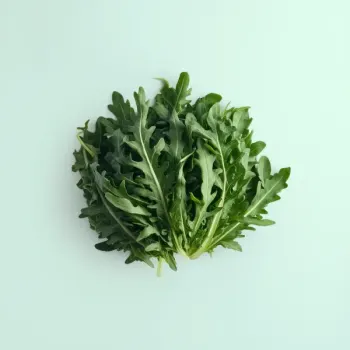Basil and arugula are flavorful, leafy greens used in cooking, each with a distinctive taste—basil being sweet and aromatic, and arugula offering a peppery kick. They can be used in salads, pizzas, and pasta dishes, either as complementary herbs or as main ingredients.

Basil, also known as sweet basil, is an aromatic herb from the mint family known for its glossy green leaves and a sweet, slightly peppery flavor. It's a staple herb in Italian cuisine and is often used fresh in recipes like pesto, caprese salad, and as a garnish on pizzas and pastas.

Arugula, also called rocket, is a leafy green with a peppery, slightly bitter taste. It belongs to the Brassicaceae family, which also includes broccoli and kale. Arugula is commonly used in salads, as a pizza topping post-baking, and as a flavor accent in pasta and grain dishes.
Basil and arugula differ significantly in flavor, with basil imparting a sweet and fragrant note while arugula offers a bold peppery kick. Texturally, basil leaves are soft and smooth, whereas arugula has a more fibrous, sometimes crunchy texture. Basil is commonly used as a complementary herb, whereas arugula can serve as both a green base and a flavor enhancer. Additionally, basil originates from tropical regions, while arugula is native to the Mediterranean area.

Your ultimate Recipe Box, Meal Planner, and Cooking Class all in one
In salads, fresh basil can add a touch of sweetness and a pop of greenery. It pairs well with ingredients like tomatoes, mozzarella, and balsamic vinaigrette. Basil is best used as an accent herb rather than the main green due to its intense flavor. Arugula serves as an excellent salad base, providing a peppery foundation that complements a variety of dressings and toppings such as shaved parmesan, pine nuts, and lemon vinaigrette. Its robust flavor can stand up to stronger ingredients like grilled steak or roasted vegetables.
Basil is a classic pizza topping, often added fresh after baking to maintain its aroma and flavor. It complements traditional margherita pizzas and pairs well with tomato-based sauces, mozzarella cheese, and a drizzle of olive oil. Arugula is typically added to pizza after baking so it retains its texture and peppery bite. It's particularly suited for white pizzas with ingredients like prosciutto, goat cheese, or truffle oil, adding a fresh, zesty dimension to each slice.
Basil shines in pasta dishes, especially when used in fresh pesto sauce or as a garnish. Its sweet flavor enhances tomato-based sauces and complements ingredients like garlic, pine nuts, and Parmesan cheese. Arugula can be incorporated into pasta dishes as a wilted green, adding a peppery contrast to creamy sauces or tossed with lemon and olive oil for a light, refreshing pasta salad. It pairs well with bold flavors such as sundried tomatoes, olives, and feta cheese.
Both basil and arugula are low in calories and contain various vitamins and minerals.
| Nutrient | Basil ( per Cup (raw) ) | Arugula ( per Cup (raw) ) |
|---|---|---|
| Fat | 0.04g | 0.1g |
| Protein | 0.2g | 0.5g |
| Calories | 2 | 5 |
| Manganese | 0.24mg | |
| Vitamin K | 21.9mcg | 21.7mcg |
| Carbohydrates | 0.4g | 0.7g |
Basil can be used as an accent in salads, but due to its strong flavor, it might not be suitable as a complete substitute for the base green arugula provides.
This depends on personal preference. Basil offers a classic flavor, especially on margherita pizzas, while arugula adds a peppery zest, often preferred on white pizzas.
Yes, arugula can be used to make a peppery variation of pesto, although the taste will differ from traditional basil pesto.
Both are healthy, low-calorie options rich in vitamins and minerals. The choice between them should be based on dietary needs and flavor preference.
Use arugula sparingly when substituting for basil, as it has a stronger, more peppery flavor that can dominate a dish if overused.